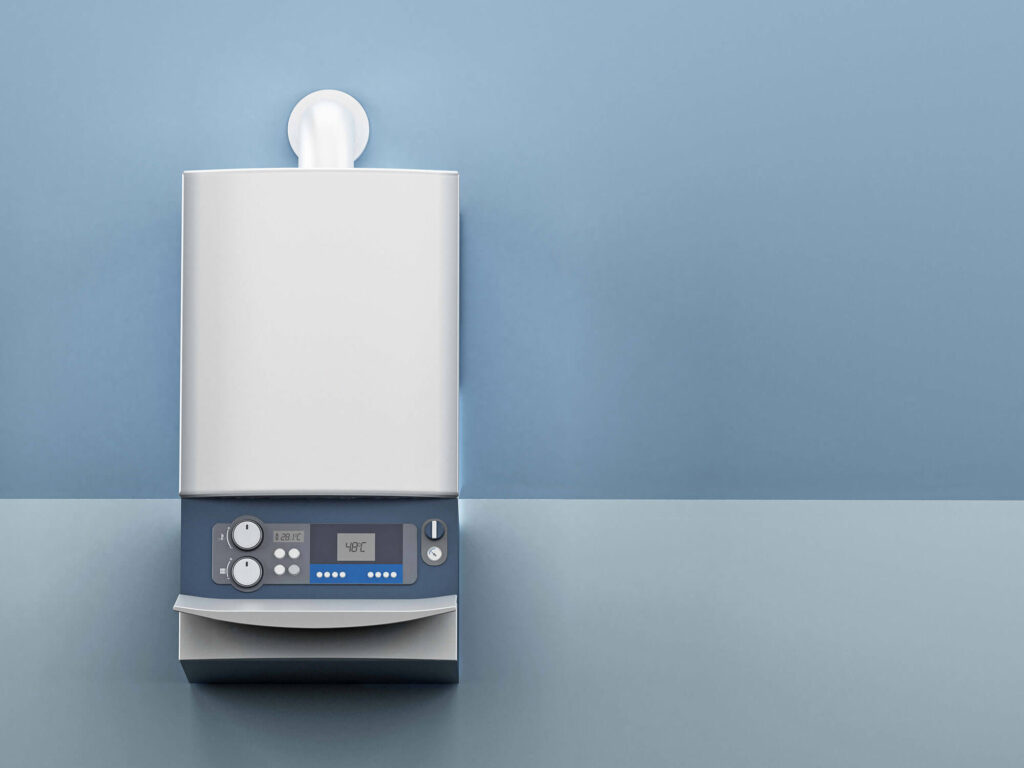Choose the right hydronic boiler with confidence. This guide covers heat-loss sizing, boiler types (modulating condensing, combi, cast-iron), hydronic design, venting/combustion air, domestic hot water options, installation best practices, total cost of ownership, and what to ask your contractor—tailored for homeowners across the Greater Toronto Area (GTA).

Quick Highlights
-
Right-size first: Room-by-room heat-loss calculation and emitter survey (radiators/baseboard/radiant)
-
Efficiency that matters: Modulating condensing (mod-con) + outdoor reset = highest real-world savings
-
Comfort upgrades: ECM circulators, zoning or TRVs, hydraulic separation, air/dirt/mag separation
-
Domestic hot water choices: Combi vs. boiler + indirect tank
-
Code & safety: Direct/concentric venting, combustion air, condensate neutralizer, relief valve & expansion tank
-
Pro commissioning: Combustion analysis, purge/bleed, delta-T verification protect performance and warranty
Boiler Types (At a Glance)
Modulating Condensing (Mod-Con)
-
How it works: Adjusts firing rate (e.g., 10:1 turndown) and condenses at low return temps to capture extra heat.
-
Best for: Highest efficiency and very steady comfort. Ideal with radiant floors, panel rads, and well-sized baseboard.
Combi Boiler (Heat + On-Demand DHW)
-
How it works: One wall-hung unit for space heat and domestic hot water.
-
Best for: Space-saving installs and small–medium DHW demand. For large tubs or simultaneous showers, consider a boiler + indirect tank.
Heat-Only Boiler + Indirect Water Heater
-
How it works: Boiler heats a separate, super-insulated tank via coil.
-
Best for: Families with high DHW needs, fastest recovery, excellent longevity.
Cast-Iron (Atmospheric/Power-Vent) Replacement
-
How it works: Fixed-fire heat exchanger, typically higher water temps.
-
Best for: Straightforward swaps where distribution requires high temperatures.
Fuels: Natural gas or propane (electric boilers in special applications).

-
Manual/Room-by-room heat-loss accounts for insulation, windows, orientation, and air-tightness.
-
Emitter output check: Confirm radiators/baseboard can deliver required BTUs at target water temps.
-
Design water temperatures:
-
Radiant floors: ~120–150°F (49–66°C) supply
-
Baseboard/radiators: ~140–180°F (60–82°C) supply
Lower temps let mod-cons condense more often for higher efficiency.
-
-
Hydraulic separation: Primary–secondary piping or a low-loss header prevents pump conflicts and short-cycling.
-
Pumping strategy: Right-sized ECM circulators, design ΔT ≈ 20°F (≈11°C), balancing valves.
-
Air/dirt/mag separation: Automatic air vents, microbubble separators, and magnetic filters protect pumps and exchangers.
-
Zoning: Zone valves/circulators or TRVs on radiators for room-by-room control.
-
Mixing: Radiant manifolds may need mixing valves to keep slab temps safe and stable.
-
Outdoor reset: Adjusts water temperature to outdoor conditions—smoother comfort and reduced fuel use.
-
Turndown ratio (e.g., 10:1): Wider modulation = quieter, longer, more efficient burns.
-
Smart thermostats & zone panels: Better scheduling, remote access, and data.
-
Quiet operation: Low-NOx burners, insulated cabinets, and variable pumps keep sound levels down.
-
AFUE is the nameplate rating; real results depend on return water temperature, run time, and installation quality.
-
Mod-cons reach peak efficiency when return water is below ~130°F (54°C) to enable condensing.
-
Pair efficiency with proper venting/combustion air, outdoor reset, and hydraulic separation for best savings.
-
Direct/concentric venting for mod-cons; chimney liner/power vent for non-condensing and some cast-iron units.
-
Respect clearances, termination placements, and intake/exhaust separation.
-
Condensate from mod-cons must be neutralized and drained with proper slope.
-
Gas line sizing & regulator capacity must match boiler input to avoid ignition faults and noise.
-
Combi: Space-saving, great for moderate demand; DHW flow is limited by boiler size and winter inlet temps.
-
Indirect tank: Highest DHW performance and efficiency, with priority control and excellent recovery.
-
Heat-loss & emitter survey, piping design, and vent route plan
-
Permits and code compliance (TSSA, local)
-
Primary–secondary or low-loss header, air/dirt/mag separators, expansion tank, backflow/PRV
-
Venting & combustion air to spec; condensate neutralizer installed and tested
-
Gas pressure verification and combustion analysis (O₂/CO/CO₂) at commissioning
-
Purge/bleed air, set outdoor reset curve, verify ΔT and zone balance
-
Owner training and full documentation (manuals, warranty, maintenance schedule)
-
Good: Cast-iron replacement, ECM circulator, chimney liner/power vent, basic reset (if supported)
-
Best for: Durable, simple systems requiring higher water temps
-
-
Better: Mod-con heat-only + indirect tank, low-loss header, ECM pumps, outdoor reset, air/dirt/mag separation
-
Best for: Top comfort, strong DHW recovery, great efficiency
-
-
Best: Premium mod-con (10:1) with smart zoning/TRVs, web-enabled controls, full water-quality package, and DHW recirculation
-
Best for: Maximum efficiency, quietest operation, best hot-water convenience
-
(We present multiple model options during your quote.)
Consider equipment + installation + energy + maintenance over 15–20 years. Mod-cons with outdoor reset and proper hydronic design often pay back via lower fuel use and improved comfort—especially with available rebates.
-
Age: Cast-iron ~20–30 years; mod-cons often 15–20 with maintenance
-
Major failures: Repeated lockouts, leaking heat exchanger, obsolete controls
-
Inefficiency: High bills, short-cycling, or distribution issues that a redesign can solve
We provide a repair-vs-replace comparison including projected fuel savings and incentives.
-
Annual tune-up with combustion analysis and gasket/seal inspection
-
Clean heat exchangers (mod-con), inspect burners and condensate/neutralizer
-
Service air/dirt/mag separators, bleed air, check expansion tank pre-charge
-
Verify outdoor reset curve each season and confirm safe operation of relief valves
Add our Boiler Protection Plan for annual tune-ups, priority service, repair discounts, and safety checks (combustion analysis, CO/venting review, relief valve & expansion tank inspection, low-water cutoff verification).
-
Will you perform a room-by-room heat-loss and emitter survey?
-
How will you handle hydraulic separation (primary–secondary or low-loss header)?
-
What’s the planned turndown ratio, outdoor reset setup, and ΔT target?
-
Are air/dirt/mag separators, expansion tank, and backflow/PRV included?
-
How will you vent the boiler and manage condensate neutralization?
-
For DHW, should I choose combi or indirect tank, and why?
-
What warranty and maintenance schedule do you recommend?
- Get a Boiler
- Boiler Repair
- Boiler Rebates & Incentives
- Boiler Buyer’s Guide
How do I size a boiler for my home?
With a room-by-room heat-loss calculation and an emitter output check. Sizing to the building—not the old boiler—prevents short-cycling and saves fuel.
Will my existing radiators work with a mod-con?
Yes—often better. Lower water temps improve condensing efficiency; add TRVs for room-level comfort.
Combi vs. indirect tank—how do I choose?
Pick combi for space savings and moderate DHW demand; choose indirect for multiple simultaneous showers or large soaker tubs.
Do I need new piping?
Not always. Many systems benefit from adding primary–secondary or a low-loss header, proper pumps, and air/dirt/mag separation.
How long does installation take?
Most replacements are completed in 1–2 days, depending on piping complexity and DHW options.
What’s the benefit of outdoor reset?
It matches water temperature to weather, delivering smoother comfort and lower fuel use—key for real-world efficiency.
Keep it running like new
Add our Boiler Protection Plan for annual tune-ups, priority service, repair discounts, and safety checks—including combustion analysis, CO/venting review, pressure relief valve & expansion tank inspection, and low-water cutoff verification. Preventive maintenance extends boiler life, improves efficiency, and keeps your home heating reliable.
Ready for quieter, more efficient heat? Book your free in-home quote today.
- Phone: (905) 895-7787
- Email Us: Send Email
- Service Area: Greater Toronto Area
At Coffee Heating and Air Conditioning, we proudly offer a full spectrum of residential and commercial HVAC services across Toronto and the Greater Toronto Area. From expert installation of high-efficiency furnaces, air conditioners, boilers, and water heaters to precision repairs, emergency service calls, and routine system maintenance, our certified technicians ensure year-round comfort and safety for every client. We also specialize in air quality improvements, duct cleaning, smart thermostat integration, and energy-saving upgrades tailored to your home or business. Whether you’re building new, upgrading, or need fast repairs, our team delivers responsive, reliable solutions backed by industry expertise and a commitment to excellence.
